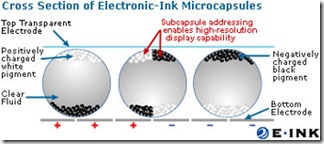E-Ink
E-ink (electronic ink) is in the news a lot, but what is it.
Before the technical, some general information. E-ink display are found in a lot of e-readers, some mobile phones and similar devices and the intent is to provide a reading experience closer to that of ink on paper than conventional LCD displays deliver. E-ink screens are not backlit and require light falling on them in the same was as reading a book does; reducing eye strain during long reading sessions. An e-ink page is also persistent (does not need power to maintain the text) and power is only required for changing text on the page. The persistent nature of the pages leads to longer times between charging.
How it Works
The developer (and I believe only supplier) of the technology is E Ink Corporation. They developed the technology based on research by MIT Media Lab. To understand how e-ink displays work, he following description is taken from the developers website:
 The principal components of electronic ink are millions of tiny microcapsules, about the diameter of a human hair. In one incarnation, each microcapsule contains positively charged white particles and negatively charged black particles suspended in a clear fluid. When a negative electric field is applied, the white particles move to the top of the microcapsule where they become visible to the user. This makes the surface appear white at that spot. At the same time, an opposite electric field pulls the black particles to the bottom of the microcapsules where they are hidden. By reversing this process, the black particles appear at the top of the capsule, which now makes the surface appear dark at that spot.
The principal components of electronic ink are millions of tiny microcapsules, about the diameter of a human hair. In one incarnation, each microcapsule contains positively charged white particles and negatively charged black particles suspended in a clear fluid. When a negative electric field is applied, the white particles move to the top of the microcapsule where they become visible to the user. This makes the surface appear white at that spot. At the same time, an opposite electric field pulls the black particles to the bottom of the microcapsules where they are hidden. By reversing this process, the black particles appear at the top of the capsule, which now makes the surface appear dark at that spot.
To form an E Ink electronic display, the ink is printed onto a sheet of plastic film that is laminated to a layer of circuitry. The circuitry forms a pattern of pixels that can then be controlled by a display driver. These microcapsules are suspended in a liquid "carrier medium" allowing them to be printed using existing screen printing processes onto virtually any surface, including glass, plastic, fabric and even paper. Ultimately electronic ink will permit most any surface to become a display, bringing information out of the confines of traditional devices and into the world around us.
If your interested in finding out more, the manufacturers site (see links below) has a downloadable video explaining the process. Currently the screens are only black and white (or grayscale). Colour e-ink is being developed but it will be some years before we see devices on the market.
Related Links